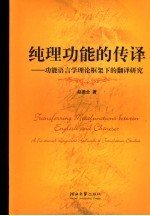

纯理功能的传译 功能语言学理论框架下的翻译研究PDF格式文档图书下载
- 购买点数:10 点
- 作 者:赵德全著
- 出 版 社:保定:河北大学出版社
- 出版年份:2007
- ISBN:7810971859
- 标注页数:202 页
- PDF页数:223 页
Chapter 1 Introduction 1
1.1 Introduction 1
1.2 Theoretical bases 3
1.2.1 Systemic analysis on attempted texts 3
1.2.2 Traditional Chinese translation theory 4
1.2.3 Contemporary western theories 6
1.3 The statement of the problems 7
1.4 The goals of the study 8
1.5 The scope of the study 10
1.6 Procedures 10
1.7 The outline of the study 11
Chapter 2 Faithfulness and Equivalence 14
2.1 Introduction 14
2.2 Faithfulness 15
2.2.1 The early concept of faithfulness in translation 15
2.2.2 Xuan Zang's faithfulness 16
2.2.3 Translation practice following the Tang dynasty 18
2.2.4 Yan Fu's faithfulness 19
2.2.5 Translation theory in present China 23
2.3 Equivalence 26
2.3.1 Nida's concept of equivalence 26
2.3.2 Catford and translation equivalence 29
2.4 Systemic view on translation and equivalence 33
2.5 Summary 38
Chapter 3 Transferring Ideational Function 40
3.1 Introduction 40
3.2 Systemic functional perspective on languages 42
3.3 Metafunctions 42
3.4 Ideational functions and transitivity system 44
3.5 Preservation of ideational components 57
3.6 Ideational components in poetry 64
3.7 Shifts in translation 68
3.7.1 Order shifts 69
3.7.2 Rank shift 70
3.7.3 Structure shift 72
3.8 Summary 75
Chapter 4 Transferring Interpersonal Function 77
4.1 Introduction 77
4.2 Interpersonal function of language 79
4.2.1 Speech functions 80
4.2.2 Constituents of the mood 82
4.2.3 Constituents of the residue 83
4.2.4 Modality 86
4.3 Transferring interpersonal function 88
4.3.1 The interpersonal meaning in the ideational content 88
4.3.2 Prioritized interpersonal function 90
4.3.3 Transferring interpersonal function in opera translation 93
4.3.4 Transferring interpersonal function in novel translation 105
4.4 The balance between ideational function and interpersonal function 114
4.5 Summary 116
Chapter 5 Transferring Textual Function 118
5.1 Introduction 118
5.2 Textual function of languages 119
5.2.1 Theme and rheme 120
5.2.2 Given and new 124
5.2.3 Cohesion and coherence 126
5.3 Transferring textual function 128
5.3.1 Theme-rheme system in translation 129
5.3.2 Information system in translation 134
5.3.3 Focus-shifts in translation 140
5.3.4 Cohesion and coherence in translation 149
5.4 Summary 159
Chapter 6 Literal Translation and Free Translation 161
6.1 Introduction 161
6.2 Traditional concepts of literal and free translation 162
6.2.1 Early concepts of literal and free translation in China 162
6.2.2 Xuan Zang's strategy in Buddhist translation 164
6.2.3 Yan Fu—a practitioner of free translation 166
6.2.4 Lu Xu's adherence to the literal translation 168
6.2.5 Concepts of literal translation and free translation in western countries 169
6.2.6 Xu Yuanchong's summary on literal and free translation 171
6.3 Functional perspective on literal and free translation 173
6.3.1 Nature of literal and free translation 173
6.3.2 Automatization and de-automatization 177
6.3.3 Transferring ideational function:from literal translation to free translation 180
6.4 Summary 185
Chapter 7 Conclusion 187
7.1 Introduction 187
7.2 Questions involved 188
7.3 Major findings 189
7.4 Implications and applications 192
7.5 Limitations and suggestions 193
Bibbiography 195
- 《纯理功能的传译 功能语言学理论框架下的翻译研究》赵德全著 2007
- 《口译质量评估 功能语言学新途径》萧国政主编;欧阳倩华著 2015
- 《功能语言学与翻译研究:翻译质量评估模式建构》司明柱著 2007
- 《翻译的功能视角 从翻译功能到功能翻译》周红民著 2013
- 《同声传译基础》仲伟合主编 2010
- 《外研社翻译研究文库 巴别塔揭秘 同声传译与认知智力和感知》英文/(阿根廷)贝尔托内(BERTONE,L.E.)著 2008
- 《功能翻译理论与科技英语翻译策略研究》王苗著 2018
- 《实用中日口译、即席翻译、同声传译》周殿清编著 1999
- 《实用中日口译 即席翻译 同声传译》周殿清编著 2003
- 《功能语言学与翻译研究》王东风主编 2006
- 《中国地方志集成 河北府县志辑 30 光绪保定府志(一)》上海书店出版社编 2006
- 《中国地方志集成 河北府县志辑 31 光绪保定府志(二)》上海书店出版社编 2006
- 《中国民间故事丛书 河北保定 顺平卷》中国民间文艺家协会组织编写;罗杨总主编;甄会龙本卷主编 2016
- 《时空回眸 献礼河北保定师范附属学校120周年》赵守诠,赵蓓编著 2016
- 《中国民间故事丛书 河北保定 易县卷》中国民间文艺家协会组织编写;罗杨总主编;刘金珍本卷主编 2016
- 《中国民间故事丛书 河北保定 高阳卷》中国民间文艺家协会组织编写;罗杨总主编;孙亚珍本卷主编 2016
- 《中国民间故事丛书 河北保定 满城卷》中国民间文艺家协会组织编写;罗杨总主编;浩渺本卷主编 2016
- 《中国民间故事丛书 河北保定 清苑卷》中国民间文艺家协会组织编写;罗杨总主编;樊新旺本卷主编 2016
- 《中国民间故事丛书 河北保定 定州卷》中国民间文艺家协会组织编写;罗杨总主编;任淑辉本卷主编 2016
- 《中国民间故事丛书 河北保定 定兴卷》中国民间文艺家协会组织编写;罗杨总主编;王振林本卷主编 2016
